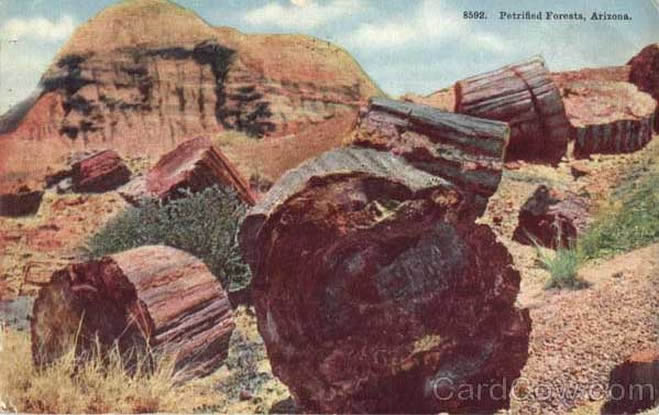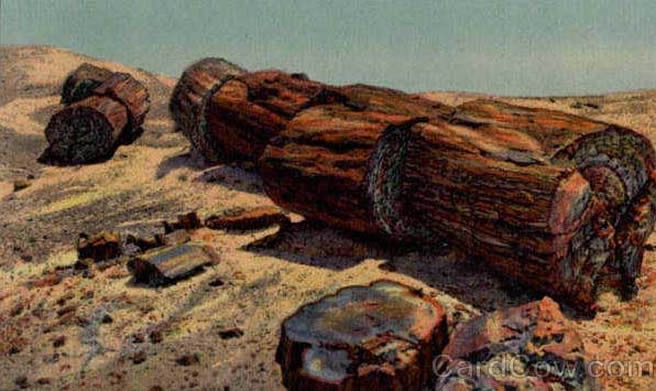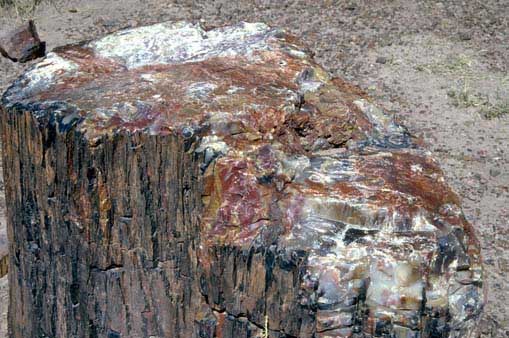Notes
From www.shannontech.com:
"Despite the dry conditions which currently exist in the Petrified Forest it has been inhabited for as long as 10,000 years. At least three prehistoric cultures--the Anasazi, the Mogollon, and the Sinagua--lived for a period in the area. The Anasazi occupied the land in the years between 1100 and 1400, living as farmers and cultivating corn, beans, and squash. It seems likely, however, that droughts in the 13th century and beyond spelled the end of the Indian civilization in the park area as inhabitants moved elsewhere to other areas.
"By 1540, when the first Spanish explorers passed through the area, Indians no longer inhabited the area. Additional exploration continued; a U.S. Army officer passed by in 1851. Captain Lorenzo Silgreaves of the U.S. Army was the first person to publish information about petrified wood in the area near the park, and the first geologist to visit the park area was Julius Marcou in 1853. The Whipple Expedition, led by Lt. Amiel W. Whipple and including 100 scientists, engineers, soldiers, and teamsters, discovered the existence of petrified wood in the park itself.
"Unfortunately, the beautiful and interesting wood specimens proved irresistible to collectors and business people, and large quantities of the petrified wood was removed. The arrival of the Atlantic and Pacific Railway in 1883 brought settlers and others to the area and more pressure on the wood. In the 1890's people were even dynamiting some of the preserved logs to gain access to the gems inside. By 1899 travel writer Charles Lummis was writing about the destruction of the unique natural resources of the park.
"The major impetus for creating a park came from a desire to protect the rapidly diminishing store of petrified wood in the park. Arizona legislator Will Barnes succeeded in persuading the territorial legislature in 1895 to request the U.S. government to create a national park in the area. Famed naturalist John Muir, who also spent time in the area, also called for creation of a park. U.S. Geological Survey paleobiologist Lester F. Ward examined the area in 1899 and recommended it be withdrawn from homesteading and saved as a national park. In 1906 President Theodore Roosevelt created the nation's second national monument in the southern portion of the current park, including only the Rainbow and Jasper Forests at that time. In 1932 the Painted Desert and Blue mesa areas were added to the monument.
"After 56 years as a national monument Petrified Forest was finally made a national park on December 9, 1962.
"The name of the park, and its major reason for creation, is the rich collection of petrified wood found mainly in the south portion of the park. It is the most spectacular collection of petrified wood ever found. In many areas large logs, stumps, and chunks of crystal may be found lying freely around the ground.
"The petrified wood found in the park began its existence as large trees from an ancient forest some 225 years ago. After falling, the trees were washed downstream from as far as 50 miles away onto a flood plain which lay on the current area of the park. The logs were covered by volcanic sand and silt sometimes to a depth of 1100 feet.
"Over time, as water seeped toward the buried logs waterborne silica slowly replaced the wood, creating the petrified logs.
"In some sections fairly large sections of trees can be found lying about. The largest is 'Old Faithful', found in the Rainbow Forest in the southern section of the park. This specimen has a diameter of 9 1/2 feet.
"In some cases the process of petrification duplicated the microscopic structure of the original tree, while in other cases the cell walls were dissolved in the process of petrification."

Postcard of petrified wood. Postcard from CardCow.com.

Postcard of petrified wood. Postcard from CardCow.com.


